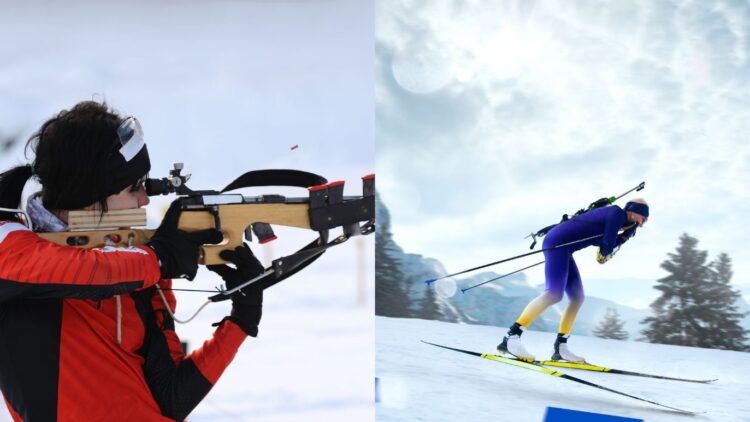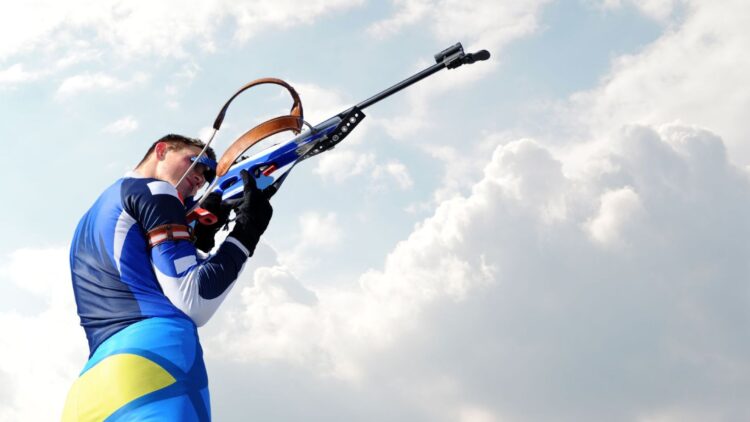
OBJECTIVE OF BIATHLON: Be the first to cross the finish line after completing a long cross-country skiing race and occasionally stopping to fire at numerous targets.
NUMBER OF PLAYERS: Not specified; usually 20+ players
MATERIALS: Skis, boots, poles, rifle
TYPE OF GAME: Sport
AUDIENCE: 15+
OVERVIEW OF BIATHLON

The biathlon is a winter sport that combines elements of cross-country skiing and rifle shooting. Athletes race along a cross-country trail, occasionally stopping at various points to fire multiple shots at targets down a shooting lane. An athlete’s accuracy ultimately dictates how much distance they must cover in the next part of the race.
Historically, the biathlon is thought to have resulted from early Scandinavian skiing traditions that had to do with the Norse god Ullr, who was the both the ski god as well as the god of hunting. This cultural tradition quickly grew into a form of alternative military training for modern Norwegians, with the ski-and-shoot style of the training being featured alongside military versions of other modern skiing events, such as downhill and slalom.
Soon after, this combination of skiing and shooting was featured at the Winter Olympics a few times between 1924 and 1948 when it went by the name “military patrol”. In 1955, the sport officially became known as “biathlon” under an international governing body, international biathlon union IBU for short, essentially becoming the civilian version of the military patrol drills. This same year, the sport officially became reinstated as an Olympic event, where it has remained ever since.
SETUP
EQUIPMENT
- Skis: Biathletes use cross-country skis that are very narrow and long compared to Alpine skis.
- Poles: Biathletes use two ski poles to help propel themselves through the snow. These poles cannot be longer than the skier’s height.
- Boots: Cross-country skiing boots use bindings that attach the skier’s toes to the skis.
- Rifle: Competitors carry ammunition and small-bore rifles weighing roughly 8 pounds. Athletes frequently use arm cuffs to help with aiming, and all athletes wear harnesses to carry their rifles on their backs while skiing.
GAMEPLAY

EVENTS
At the Winter Olympics, there are five different biathlon events: individual, sprint, pursuit, mass start, and relay. Although each event is different, they all still function as a biathlon and hold many similarities as a mixed relay.
Each event involves competitors skiing a number of laps around a long track. In Biathlon competitions, each event will have a shooting bout. In these shooting bouts the athlete will be given ammo and must make their way to a shooting stage. After completing each lap, they stop at a shooting range to shoot at five targets from various positions (prone position and standing). If an athlete fires to a missed target, they are penalized by having to ski a further distance for the next lap or receiving a time penalty. Depending on the event format, the winner of the biathlon is either the athlete who crosses the finish line first or the athlete with the quickest finishing time.
In Biathlon competitions, each event will have a shooting bout. In these shooting bouts the athlete will be given ammo and must make their way to a shooting stage.
INDIVIDUAL
- Distance: 20 km (12.43 miles) for men, 15 km (9.32 miles) for women
- Start: Interval/staggered (30 seconds apart)
- Shooting Format: 4 rounds (5 shots per round); athletes alternate between standing and prone positions for each round
- Shooting Penalty: A missed shot adds 1 minute to the athlete’s time
- Win Condition: Fastest finishing time
SPRINT
- Distance: 10 km (6.21 miles) for men, 7.5 km (4.66 miles) for women
- Start: Interval/staggered
- Shooting Format: 2 rounds (5 shots per round); one prone and one standing
- Shooting Penalty: Each miss requires one lap to be completed in the penalty loop (150 m)
- Win Condition: Fastest finishing time
PURSUIT
- Distance: 12.5 km (7.76 miles) for men, 10 km (6.21 miles) for women
- Start: Interval/staggered; athletes begin the race based on their finishing times from the individual and sprint events
- Shooting Format: 4 rounds (5 shots per round); the first 2 rounds are in the prone position, and the next 2 in the standing position
- Shooting Penalty: Each miss requires one penalty lap to be completed (150 m)
- Win Condition: First to cross the finish line
MASS START EVENTS
- Distance: 15 km (9.32 miles) for men, 12.5 km (7.76 miles) for women
- Start: Mass start (all athletes start at the same time)
- Shooting Format: 4 rounds (5 shots per round); first 2 rounds are prone, the next 2 are standing
- Shooting Penalty: Each miss requires one penalty lap to be completed (150 m)
- Win Condition: First to cross the finish line
RELAY
- Distance: 4×7.5 km (men), 4×6 km (women)
- Start: The first member of each team begins the race in a mass start
- Shooting Format: 2 rounds per athlete (one prone, one standing; athletes are given 8 shots to hit 5 targets each round, with the 3 (as needed) extra shots having to be hand-loaded
- Shooting Penalty: Failure to hit all 5 targets results in one penalty lap (150 m)
- Win Condition: The first team to cross the finish line wins
SKATE SKIING
For the cross-country skiing portion of the biathlon, athletes can use any style of skiing they wish. For the most part, however, all athletes use some variation of a technique known as “skate skiing”, as this is considered the most effective method of skiing on firm snowy surfaces (as opposed to fresh, undisturbed snow).
Skate skiing consists of two main variations: “offset” (V1) and “one skate” (V2). Both variations somewhat resemble the motion of ice skating. The offset technique vaguely resembles a walking motion and is usually centered around a skier’s “dominant” leg, using both ski poles to propel themselves forward each time their chosen leg is in front. Meanwhile, the one-skate technique involves the skier bringing both skis close together and pushing themselves forward at a diagonal angle. The skier alternates between propelling off their left and right feet, using both ski poles each time they do so.
Check out these skiing techniques in motion:
Three Basic Skate Ski Techniques Explained
END OF GAME
Depending on the event, the winner of the biathlon is the athlete/team that crosses the finish line in the least amount of time or before all other competitors, depending on the event.
- 30 GAMES TO PLAY OVER TEXT - April 22, 2024
- 20+ FREE PRINTABLE BABY SHOWER GAMES - April 16, 2024
- 20+ College Party Games for the Best Night Ever! - April 2, 2024